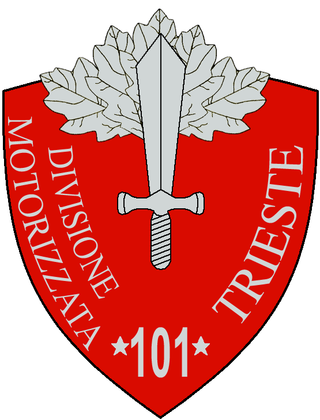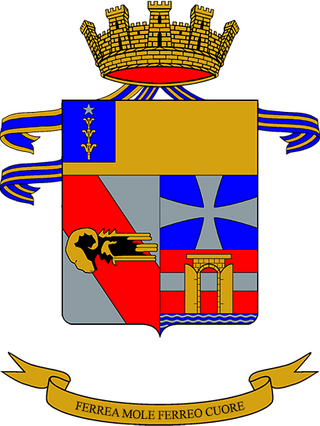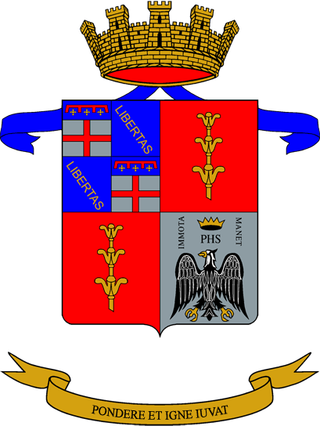
Operation Compass was the first large British military operation of the Western Desert Campaign (1940–1943) during the Second World War. British metropolitan, Imperial and Commonwealth forces attacked the Italian and Libyan forces of the 10th Army in western Egypt and Cyrenaica, the eastern province of Libya, from December 1940 to February 1941.

The 1st CC.NN. Division "23 Marzo" was an Italian CC.NN. division raised on 23 April 1935 for the Second Italo-Ethiopian War against Ethiopia. The name "23 Marzo" was chosen to commemorate the founding date of the Fasci Italiani di Combattimento on 23 March 1919. The division took part in the Italian invasion of Egypt and was destroyed during the Battle of Bardia in January 1941.
The 10th Army was a field army of the Royal Italian Army, which fought in World War I and in Italian North Africa during World War II.

The 2nd CC.NN. Division "28 Ottobre" was an Italian CC.NN. division raised on 10 May 1935 for the Second Italo-Ethiopian War against Ethiopia. The name "28 Ottobre" was chosen to commemorate the Fascist March on Rome on 28 October 1922. The division took part in the Italian invasion of Egypt and was destroyed during the Battle of Bardia in January 1941.

The 102nd Motorized Division "Trento" was a motorized infantry division of the Royal Italian Army during World War II. The division was formed in 1935 and named for the city of Trento, where its infantry and artillery regiments were based. The Trento served in the Western Desert Campaign and was destroyed in the Second Battle of El Alamein in November 1942.

101st Motorized Division "Trieste" was a motorized infantry division of the Royal Italian Army during World War II. The Trieste was formed in 1939 and named for the city of Trieste. The division and its infantry and artillery regiments were based in Piacenza, while the 9th Bersaglieri Regiment was based until 1940 in Treviso and then moved to Cremona to be closer to the division. In September 1941 the Trieste was transferred to Libya for the Western Desert Campaign. The division was decimated in the Second Battle of El Alamein, but was rebuilt with the survivors of destroyed divisions. The Trieste then participated in the Tunisian Campaign until Axis forces in Tunisia surrendered to allied forces on 13 May 1943.

The Italian invasion of Egypt was an offensive in the Second World War from Italian Libya, against British, Commonwealth and Free French in the neutral Kingdom of Egypt. The invasion by the Italian 10th Army ended border skirmishing on the frontier and began the Western Desert Campaign (1940–1943) proper. The Italian strategy was to advance from Libya along the Egyptian coast to seize the Suez Canal. After numerous delays, the scope of the offensive was reduced to an advance as far as Sidi Barrani and the defeat of any British forces in the area.

The Maletti Group(Italian: Raggruppamento Maletti) was an ad hoc mechanised unit formed by the Italian Army in Italian North Africa, early in the Western Desert Campaign of the Second World War. The Italian army had three armoured divisions in Europe but all were needed for the occupation of Albania and the forthcoming invasion of Greece, which began on 28 October 1940. The Raggruppamento Maletti was formed in June 1940, as part of the 10th Army and contained all of the M11/39 medium tanks in Libya.

The 11th Infantry Division "Brennero" was a infantry division of the Royal Italian Army during World War II. The Brennero was classified as a mountain infantry division, which meant that the division's artillery was moved by pack mules instead of the horse-drawn carriages of line infantry divisions. Italy's real mountain warfare divisions were the six alpine divisions manned by Alpini mountain troops. The Brennero was named for the Brenner Pass between Italy and Austria. The division was based in the western half of South Tyrol with the division's headquarter in Bolzano.
The 2nd Libyan Division was an infantry division of the Royal Italian Army during World War II. In December 1940 the division formed, together with the 1st CC.NN. Division "23 Marzo" and 2nd CC.NN. Division "28 Ottobre", the XXIII Army Corps. The corps participated in the Italian invasion of Egypt and was destroyed during the Battle of Sidi Barrani.

The 18th Infantry Division "Messina" was an infantry division of the Royal Italian Army during World War II. The Messina was named for the city of Messina and based primarily in the Marche region, where it also recruited most of its troops. The division's headquarter and 93rd Infantry Regiment were based in Ancona, the 94th Infantry Regiment in Fano, and the 2nd Artillery Regiment in Pesaro.

The 37th Infantry Division "Modena" was a infantry division of the Royal Italian Army during World War II. The Modena was classified as a mountain infantry division, which meant that the division's artillery was moved by pack mules instead of the horse-drawn carriages of line infantry divisions. Italy's real mountain warfare divisions were the six alpine divisions manned by Alpini mountain troops. The division was formed on 25 March 1939 with units of the 5th Territorial Division "Imperia" and named for the city of Modena. The division was made up entirely of men from the city of Genoa and the surrounding Liguria region. The division's regimental depots were shared with the 63rd Infantry Division "Cirene", which was based in Benghazi in Libya and recruited its men from and trained them in Liguria.

The 50th Infantry Division "Regina" was an infantry division of the Royal Italian Army during World War II. The Regina was formed on 1 March 1939 in the Italian Islands of the Aegean and entitled to the Queen. After the announcement of the Armistice of Cassibile between Italy and the Allies on 8 September 1943 the division fought Wehrmacht forces in the Battle of Rhodes. The majority of the division surrendered on 11 September 1943, while the III Battalion, 10th Infantry Regiment "Regina" resisted the Germans on Leros until 16 November 1943.

The 56th Infantry Division "Casale" was an infantry division of the Royal Italian Army during World War II. The Casale was activated on 15 June 1939 in Forlì and named for the city of Casale Monferrato and recruited most its men from the Romagna region. The division was sent to Greece as occupation and force. There the division was disbanded by invading German forces in the Aetolia-Acarnania region of Greece after the announcement of the Armistice of Cassibile on 8 September 1943.

The 57th Infantry Division "Lombardia" was an infantry division of the Royal Italian Army during World War II. The Lombardia was formed on 24 May 1939 in Pula and named for the region of Lombardy. The division was disbanded by the Germans after the Armistice of Cassibile was announced on 8 September 1943.
The 5th Army was a World War I and World War II field army of the Royal Italian Army.

The 32nd Tank Regiment is a tank regiment of the Italian Army based in Tauriano in Friuli-Venezia Giulia. The regiment is equipped with Ariete main battle tanks and assigned to the 132nd Armored Brigade "Ariete". On 15 September 1936 the regiment was formed by the Royal Italian Army as 2nd Tank Infantry Regiment. On 1 December 1938, the regiment was reorganized and reformed as 32nd Tank Infantry Regiment and assigned to the II Armored Brigade. In January 1941, the regiment deployed to North Africa, where it fought in the Western Desert campaign in Libya and Egypt. In December 1941, the regiment was taken out of the front and its role taken over by the 132nd Tank Infantry Regiment.

The 3rd Armored Infantry Regiment is an inactive armored warfare regiment of the Italian Army, which was based in Persano in Campania and last operationally assigned to the Infantry Division "Granatieri di Sardegna". The regiment was formed in 1927 as Armed Tanks Regiment. In 1936 the regiment was split into four tank infantry regiments and the 3rd Tank Infantry Regiment was assigned the flag and traditions of the Armed Tanks Regiment. During World War II the battalion served as central training command for all Italian tank units. The regiment was disbanded by German forces after the Armistice of Cassibile was announced on 8 September 1943.
The Italian XXI Army Corps was a formation of the Italian army in World War II.
The Italian XXII Army Corps was a formation of the Italian army in World War II.